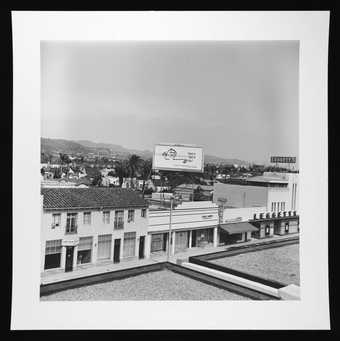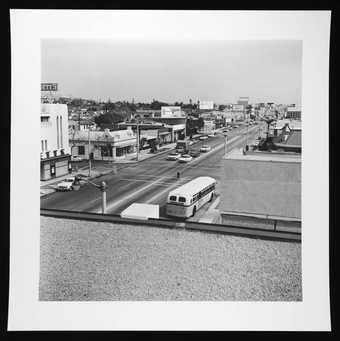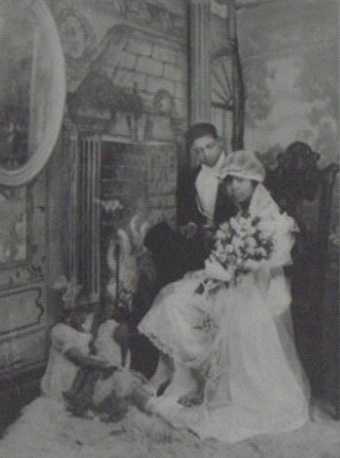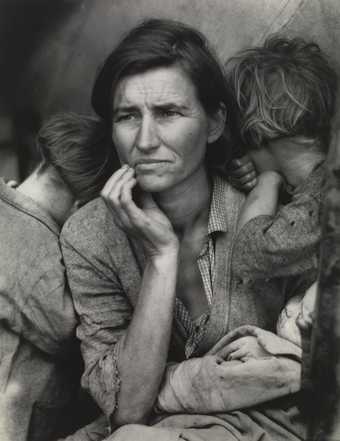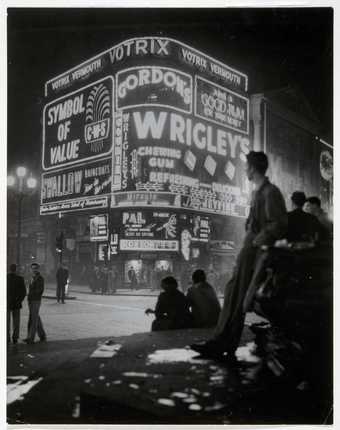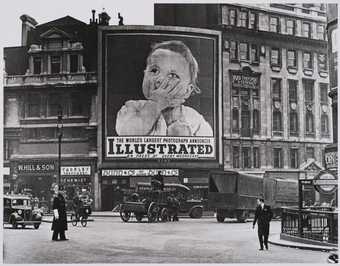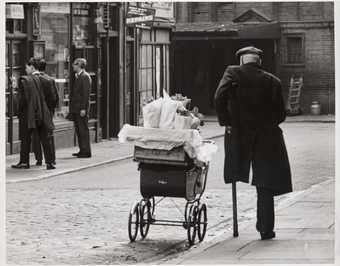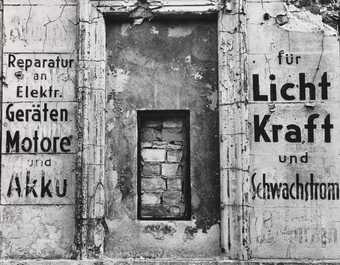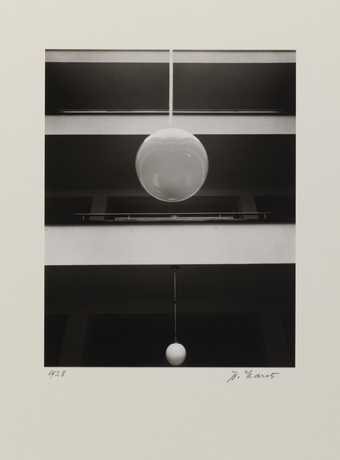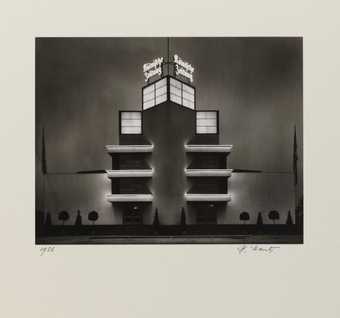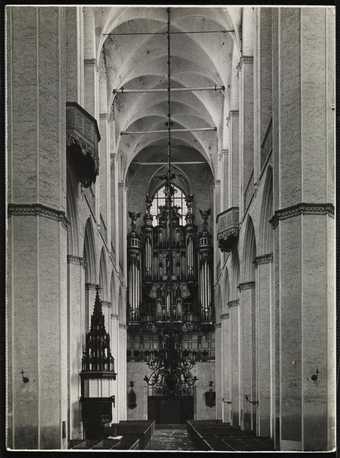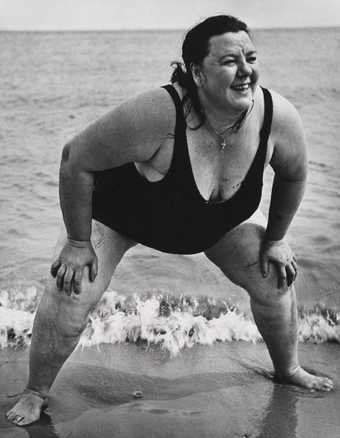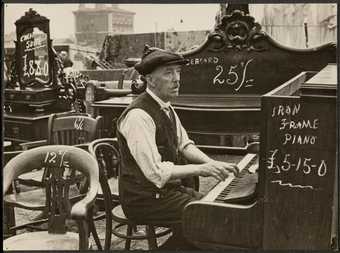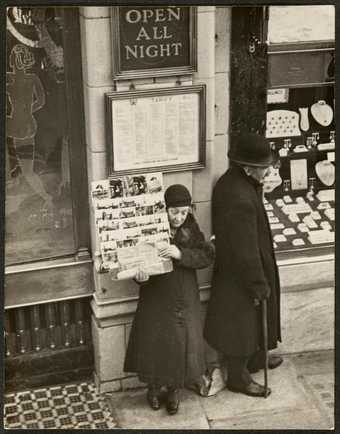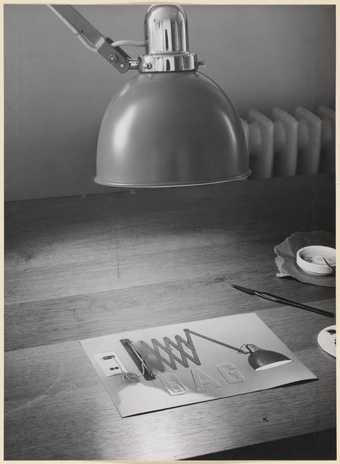Sorry, copyright restrictions prevent us from showing this object here
In Tate Britain
Prints and Drawings Room
View by appointment- Artist
- Berenice Abbott 1898–1991
- Medium
- Photograph, gelatin silver print on paper
- Dimensions
- Unconfirmed: 240 × 180 mm
- Collection
- Tate
- Acquisition
- Accepted by HM Government in lieu of inheritance tax from the Estate of Barbara Lloyd and allocated to Tate 2009
- Reference
- P13098
Summary
Dinty Moore Antiques is a black and white gelatin silver print on paper. The photograph has a portrait orientation and shows a crop of a building’s facade. On the right side of the image is a studded wooden door. In front of this a sign juts out from the wall that bears the inscription ‘Dinty Moore Antiquated Antiques’ – the name of the shop that lends itself to the work’s title. The left side of the image shows the shop’s window, through which several shelves of objects are visible, including small lamps, figurines and a latticed heart. In front of the window, on the building’s exterior, is a metal structure covered in a length of chicken wire underneath which ivy can be seen growing.
Dinty Moore Antiques was taken around 1937 by American photographer Berenice Abbott. The image, which has yellowed considerably with age, depicts an antiques shop in New York’s West Village, at 158 West 11th Street. While the shop has not survived, the building still exists as a residential space. In 1929 Abbott began to document the changing urban environment in New York City. In 1935 she received a photographic commission for this from the Works Progress Administration (WPA). The WPA was part of the Federal Art Project, initiated by Franklin D. Roosevelt under his new economic plan for Depression-era America that was termed the New Deal. The WPA sponsored Abbott to document the intense period of construction being undertaken in New York City under the New Deal’s auspices. The resulting photographs, of which Dinty Moore Antiques is one, were published in 1939 in a book entitled Changing New York.
Abbott had arrived in New York in 1918 to study journalism; however, she switched to sculpture and then relocated to continue her training in Berlin and Paris. In 1923 she answered an advertisement in Paris for a studio assistant with no previous experience, which had been posted by the painter and photographer Man Ray. The pair had first met in New York in 1918 and her lack of knowledge qualified Abbott for the job. She gained experience developing Man Ray’s prints and he encouraged her to begin taking her own photographs. In 1925 she established a studio in Paris to take the portraits of celebrated subjects, including the writer and artist Jean Cocteau and the writer James Joyce. In 1929, however, Abbott returned to New York for a short trip and was struck by the dramatic changes to the cityscape that had taken place while she had been in Europe. The photographic potential of these changes encouraged her to return to New York and document the transformation. As the curator Barbara Shissler Nosanow has observed:
Fascinated by New York City and the changes that had occurred in it in her absence she began the monumental work of documenting its visual presence – its sweeping technological innovations, its bridges, its canyonlike streets overtowered by skyscrapers (many of the most famous under construction at the time), its nineteenth century brownstones and even earlier vestiges of colonial architecture, its littered streets, its hum and vitality, its sparkling transformation at night.
(Nosanow in Berenice Abbott: The 20s and the 30s, exhibition catalogue, International Center of Photography, New York 1981, p.8.)
Abbott’s experience as a portrait photographer striving for an imaginative realism informed her later architectural photographs. In the portraits she sought to capture her relationship with the sitter. As she observed: ‘I wasn’t trying to make a still life of them but a person. It’s a kind of exchange’ (quoted in International Center of Photography 1981, p.7). Similarly, Abbott’s architectural images attempt to document her relationship with the evolving urban fabric of New York City.
Another of Abbott’s works in the Tate collection is Tri-Boro Barber Shop 1935 (Tate P13100), which is from the same series of images of New York.
Further reading
Berenice Abbott, ‘What the Camera and I See’, Art News, September 1951, pp.36–7.
Alice C. Steinbach, ‘Berenice Abbott’s Point of View’, Art in America, November–December 1976, pp.77–81.
Avis Berman, ‘The Unflinching Eye of Berenice Abbott’, Art News, January 1981, p.87.
Phoebe Roberts
May 2016
Supported by the Terra Foundation for American Art.
Does this text contain inaccurate information or language that you feel we should improve or change? We would like to hear from you.
Display caption
American photographer Abbott had been in Europe of eight years when she returned to New York for what she planned to be a short visit. There she was struck by the dramatic changes to the urban fabric that had taken place in her absence, and the city’s photographic potential. These two photographs are part of her Changing New York project, which records the city in transition, capturing old buildings on the brink of demolition as well as dramatic new constructions.
Gallery label, February 2016
Does this text contain inaccurate information or language that you feel we should improve or change? We would like to hear from you.
Explore
- architecture(30,960)
- public and municipal(2,385)
-
- shop(399)
- townscapes / man-made features(21,603)
-
- signage(467)
- formal qualities(12,454)
-
- photographic(4,673)
- fine arts and music(3,982)
-
- figurine(23)
- light / lamp(264)
- brick(56)
You might like
-
Edward Ruscha Leggett’s (Rooftops Series #3)
1961, printed 2004 -
Edward Ruscha Hancock (Rooftops Series #4)
1961, printed 2004 -
James Van Der Zee Wedding Day, Harlem
1926, printed 1974 -
Dorothea Lange Migrant Mother, Nipomo, California
1936, printed c.1950 -
Hannes Kilian Piccadilly, London
1955 -
Wolfgang Suschitzky Near Monument Station, London
1938, printed 1998 -
Lutz Dille Untitled
1961 -
Harry Shunk, János Kender Shunk-Kender ‘World Tour’ Series, Berlin
1960s -
Werner Mantz Sinn-Department store, Gelsenkirchen 1928
1928, printed 1977 -
Werner Mantz Kölnische Zeitung, Pressa, Cologne 1928
1928, printed 1977 -
Albert Renger-Patzsch From the Work: North German Brick Cathedrals, Stralsund - St Mary’s Church, Nave from the Choir
c.1928 -
Lisette Model Woman at Coney Island
1939–41, printed 1976 -
Horacio Coppola Pianist, London
1934 -
Horacio Coppola London
1934 -
Werner Bischof Untitled
1934

